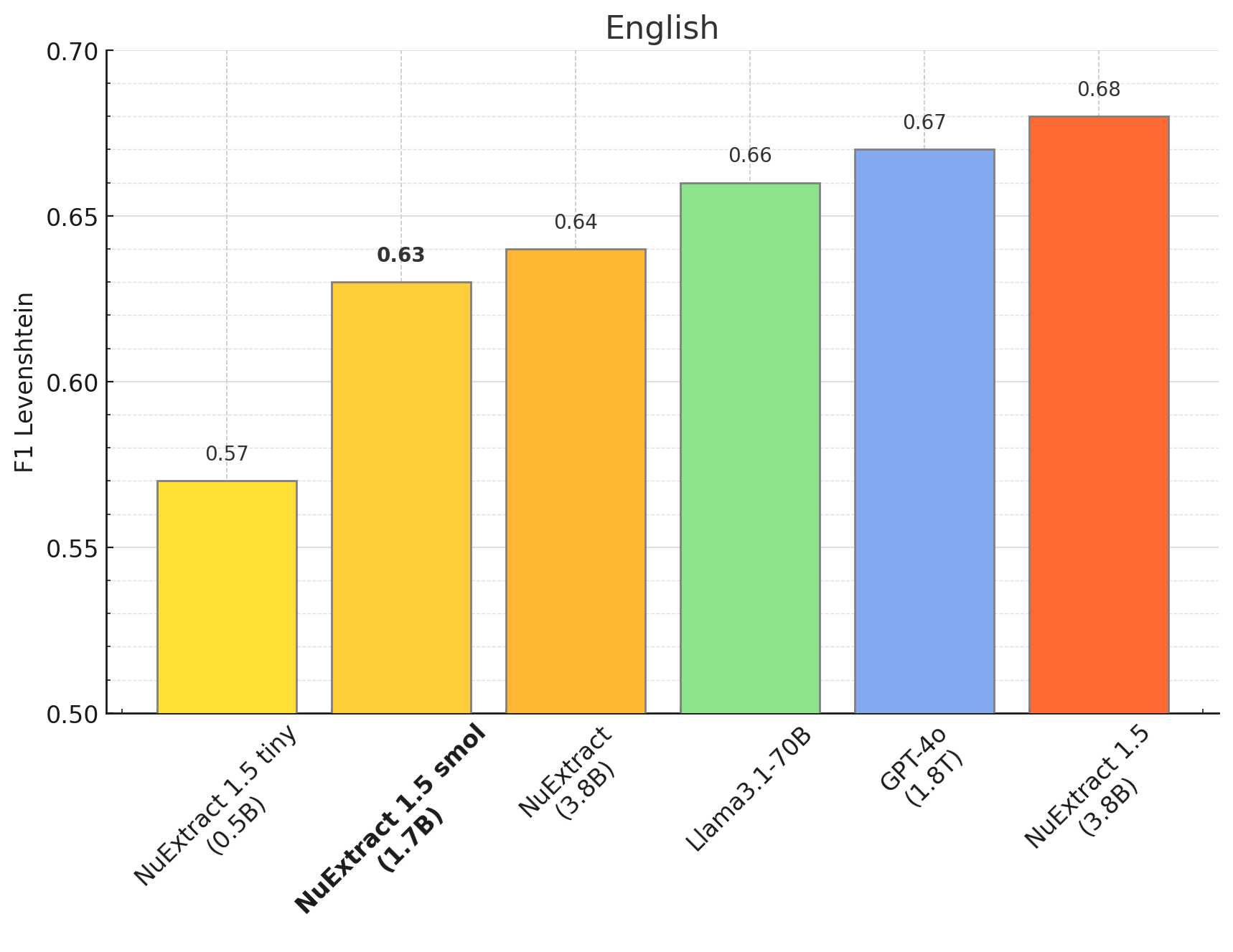---
license: mit
language:
- multilingual
tags:
- nlp
base_model: HuggingFaceTB/SmolLM2-1.7B
pipeline_tag: text-generation
inference: true
---
# NuExtract-1.5-smol by NuMind 🔥
NuExtract-1.5-smol is a fine-tuning of Hugging Face's [SmolLM2-1.7B](https://huggingface.co/HuggingFaceTB/SmolLM2-1.7B), intended for structured information extraction. It uses the same training data as [NuExtract-1.5](https://huggingface.co/numind/NuExtract-1.5) and supports multiple languages, while being less than half the size (1.7B vs 3.8B).
To use the model, provide an input text and a JSON template describing the information you need to extract.
Note: This model is trained to prioritize pure extraction, so in most cases all text generated by the model is present as is in the original text.
Check out the [blog post](https://numind.ai/blog/nuextract-1-5---multilingual-infinite-context-still-small-and-better-than-gpt-4o).
Try the 3.8B model here: [Playground](https://huggingface.co/spaces/numind/NuExtract-v1.5)
We also provide a tiny (0.5B) version which is based on Qwen2.5-0.5B: [NuExtract-tiny-v1.5](https://huggingface.co/numind/NuExtract-tiny-v1.5)
⚠️ We recommend using NuExtract with a temperature at or very close to 0. Some inference frameworks, such as Ollama, use a default of 0.7 which is not well suited to pure extraction tasks.
## Benchmark
Zero-shot performance (English):

Zero-shot performance (Multilingual):

## Usage
To use the model:
```python
import json
import torch
from transformers import AutoModelForCausalLM, AutoTokenizer
def predict_NuExtract(model, tokenizer, texts, template, batch_size=1, max_length=10_000, max_new_tokens=4_000):
template = json.dumps(json.loads(template), indent=4)
prompts = [f"""<|input|>\n### Template:\n{template}\n### Text:\n{text}\n\n<|output|>""" for text in texts]
outputs = []
with torch.no_grad():
for i in range(0, len(prompts), batch_size):
batch_prompts = prompts[i:i+batch_size]
batch_encodings = tokenizer(batch_prompts, return_tensors="pt", truncation=True, padding=True, max_length=max_length).to(model.device)
pred_ids = model.generate(**batch_encodings, max_new_tokens=max_new_tokens)
outputs += tokenizer.batch_decode(pred_ids, skip_special_tokens=True)
return [output.split("<|output|>")[1] for output in outputs]
model_name = "numind/NuExtract-1.5-smol"
device = "cuda"
model = AutoModelForCausalLM.from_pretrained(model_name, torch_dtype=torch.bfloat16, trust_remote_code=True).to(device).eval()
tokenizer = AutoTokenizer.from_pretrained(model_name, trust_remote_code=True)
text = """We introduce Mistral 7B, a 7–billion-parameter language model engineered for
superior performance and efficiency. Mistral 7B outperforms the best open 13B
model (Llama 2) across all evaluated benchmarks, and the best released 34B
model (Llama 1) in reasoning, mathematics, and code generation. Our model
leverages grouped-query attention (GQA) for faster inference, coupled with sliding
window attention (SWA) to effectively handle sequences of arbitrary length with a
reduced inference cost. We also provide a model fine-tuned to follow instructions,
Mistral 7B – Instruct, that surpasses Llama 2 13B – chat model both on human and
automated benchmarks. Our models are released under the Apache 2.0 license.
Code:
Webpage: """
template = """{
"Model": {
"Name": "",
"Number of parameters": "",
"Number of max token": "",
"Architecture": []
},
"Usage": {
"Use case": [],
"Licence": ""
}
}"""
prediction = predict_NuExtract(model, tokenizer, [text], template)[0]
print(prediction)
```
Sliding window prompting:
```python
import json
MAX_INPUT_SIZE = 20_000
MAX_NEW_TOKENS = 6000
def clean_json_text(text):
text = text.strip()
text = text.replace("\#", "#").replace("\&", "&")
return text
def predict_chunk(text, template, current, model, tokenizer):
current = clean_json_text(current)
input_llm = f"<|input|>\n### Template:\n{template}\n### Current:\n{current}\n### Text:\n{text}\n\n<|output|>" + "{"
input_ids = tokenizer(input_llm, return_tensors="pt", truncation=True, max_length=MAX_INPUT_SIZE).to("cuda")
output = tokenizer.decode(model.generate(**input_ids, max_new_tokens=MAX_NEW_TOKENS)[0], skip_special_tokens=True)
return clean_json_text(output.split("<|output|>")[1])
def split_document(document, window_size, overlap):
tokens = tokenizer.tokenize(document)
print(f"\tLength of document: {len(tokens)} tokens")
chunks = []
if len(tokens) > window_size:
for i in range(0, len(tokens), window_size-overlap):
print(f"\t{i} to {i + len(tokens[i:i + window_size])}")
chunk = tokenizer.convert_tokens_to_string(tokens[i:i + window_size])
chunks.append(chunk)
if i + len(tokens[i:i + window_size]) >= len(tokens):
break
else:
chunks.append(document)
print(f"\tSplit into {len(chunks)} chunks")
return chunks
def handle_broken_output(pred, prev):
try:
if all([(v in ["", []]) for v in json.loads(pred).values()]):
# if empty json, return previous
pred = prev
except:
# if broken json, return previous
pred = prev
return pred
def sliding_window_prediction(text, template, model, tokenizer, window_size=4000, overlap=128):
# split text into chunks of n tokens
tokens = tokenizer.tokenize(text)
chunks = split_document(text, window_size, overlap)
# iterate over text chunks
prev = template
for i, chunk in enumerate(chunks):
print(f"Processing chunk {i}...")
pred = predict_chunk(chunk, template, prev, model, tokenizer)
# handle broken output
pred = handle_broken_output(pred, prev)
# iterate
prev = pred
return pred
```

